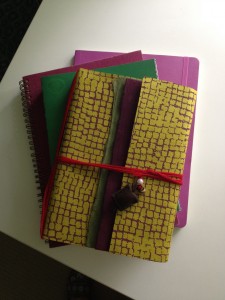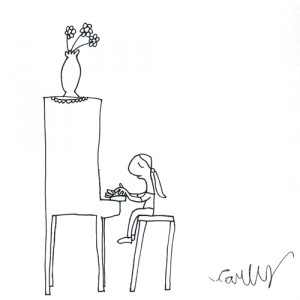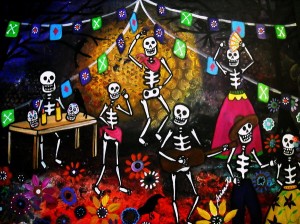Fifteen Minutes
 And now, a little more from Mary Oliver:
And now, a little more from Mary Oliver:
Freshen the Flowers, She Said
So I put them in the sink, for the cool porcelain
was tender,
and took out the tattered and cut each stem
on a slant,
trimmed the black and raggy leaves, and set them all–
roses, delphiniums, daisies, iris, lilies,
and more whose names I don’t know, in bright new water–
gave them
a bounce upward at the end to let them take
their own choice of position, the wheels, the spurs,
the little sheds of the buds. It took, to do this,
perhaps fifteen minutes.
Fifteen minutes of music
with nothing playing.
Tell the Truth
I’ve been thinking a lot lately about the Buddhist training in Wise Speech, which basically is the practice of telling the truth, in words that are kind and useful, and with the intention of bringing people together rather than driving them apart.
So for today:
Why tell the truth?
“…the commitment to truth has a significance transcending the domain of ethics and even mental purification, taking us to the domains of knowledge and being. Truthful speech provides, in the sphere of interpersonal communication, a parallel to wisdom in the sphere of private understanding. The two are respectively the outward and the inward modalities of the same commitment to what is real.
“Wisdom consists in the realization of truth, and truth is not just a verbal proposition but the nature of things as they are. To realize truth our whole being has to be brought into accord with actuality, with things as they are, which requires that in communications with others we respect things as they are by speaking the truth.
“Truthful speech establishes a correspondence between our own inner being and the real nature of phenomena, allowing wisdom to rise up and fathom their real nature.
“Thus, much more than an ethical principle, devotion to truthful speech is a matter of taking our stand on reality rather than illusion, on the truth grasped by wisdom rather than the fantasies woven by desire.”
— from The Noble Eightfold Path, by Bhikkhu Bodhi
Greed is Like This
 I’m leaving next Saturday for 3 weeks in Italy. I plan to write while I’m there and I’ve decided that writing in Italy means writing in long-hand (much more romantic that way). So of course I needed the “perfect” notebook to write in.
I’m leaving next Saturday for 3 weeks in Italy. I plan to write while I’m there and I’ve decided that writing in Italy means writing in long-hand (much more romantic that way). So of course I needed the “perfect” notebook to write in.
It has to have good quality paper with a nice smooth finish, so it takes ink smoothly and doesn’t bleed or show through; it has to be ruled, but the lines can’t be too far apart or too close together; it has to lie flat when it’s opened; it has to fit easily into my walking-around-the-streets-of-Italy shoulder bag; it has to have a back cover that’s stiff enough to act like a desktop for writing in trains and parks and museums and churches, but it can’t be too heavy; and it has to look distinctively stylish in a retro, classic, or hipster kind of way (I’ll be in Italy after all).
So I went to my favorite shop for all things notebook-y. And I found one! A medium-ruled, spiral-bound notebook, with a rose-colored, “recycled, raw, organic” felt-ed cover! It was almost perfect, but not quite, because it didn’t have a hard back cover.
But then I found another one! It had 32 custom-color fly sheets in the front and back, and deckled edges, and a special exposed-perfect-binding system so it lies completely flat when it’s open, even though it’s about an inch thick! But the back cover isn’t hard. And it’s kind of heavy — probably too bulky for my shoulder bag. And the paper is gorgeous….but not ruled.
So then I found another one! A Moleskine this time — my favorite. With a gorgeous, pinkish-lavender, faux leather cover and acid-free paper….with ruled “lines” that are dots! In a full grid pattern! The dots are a lovely, under-stated, silvery grey color. But there’s no hard cover. And, sadly, like all Moleskines, it doesn’t lie flat.
Then I found another one! This one was made in Nepal! With a fabulous hand-made paper cover with a cord tie that has a cool leather fob and a little brass bell! Inside it’s full of all kinds of different hand-made papers….different sizes and textures and colors! Even black! It’s the coolest journal EVER! But all those textured hand-made papers are hell to write on. Inks get fuzzy. And everything bleeds through. And what about that black paper? It would be a great journal for pasting things into. Or maybe drawing on with colored pencils. Or water colors! But for writing…not so much.
What to do!?!
I’m a greed type.
I bought them all.
None of them are perfect.
But I had to have them.
All.
Just Listen
 I’ve posted earlier about reading the Satipatthana Sutta out loud and having an experience that was closer to a visceral feeling of the words than a conceptual understanding of them. (full post here.) It was the English translation I was reading, of course, so I did understand what I was reading. But the repetition and the archaic style made it closer to music than text.
I’ve posted earlier about reading the Satipatthana Sutta out loud and having an experience that was closer to a visceral feeling of the words than a conceptual understanding of them. (full post here.) It was the English translation I was reading, of course, so I did understand what I was reading. But the repetition and the archaic style made it closer to music than text.
I had a similar-but-different experience of “knowing” the words — but in Pali this time — when I listened to an extraordinarily beautiful recording of the entire sutta, chanted by a Sri Lankan monk, Ven. Omalpe Sobitha Thero.
I offer it to you here, for your pleasure, and for whatever understanding comes with the experience:
To listen, start by clicking here. Then scroll down almost to the bottom of the page. Look for the Maha Satipatthana Sutta. Because the recording quality is so high, the file is quite large, so it is broken into four parts. Part 1 is an introduction in English (under 2 minutes). The chanting begins at part 2 (about 20 minutes) and ends with Part 4 (about an hour total).
It’s more than gorgeous.
Just listen.
Only a Window
 And now a little Mary Oliver, from Have You Ever Tried to Enter the Long Black Branches:
And now a little Mary Oliver, from Have You Ever Tried to Enter the Long Black Branches:
Listen, are you breathing just a little, and calling it a life?
While the soul, after all, is only a window,
and the opening of the window no more difficult
than the wakening from a little sleep.
Loving the Plateau
 Today’s quote comes from a sweet little gem of a book, Mastery: The Keys to Success and Long-Term Fulfillment, by George Leonard. (recommended by Phillip Moffitt)
Today’s quote comes from a sweet little gem of a book, Mastery: The Keys to Success and Long-Term Fulfillment, by George Leonard. (recommended by Phillip Moffitt)
“Goals and contingencies are important. But they exist in the future and the past, beyond the pale of the sensory realm. Practice, the path of mastery, exists only in the present. You can see it, hear it, smell it, feel it. To love the plateau is to love the eternal now, to enjoy the inevitable spurts of progress and the fruits of accomplishment, then serenely to accept the new plateau that waits just beyond them. To love the plateau is to love what is most essential and enduring in your life.“
Half-Full and Getting Fuller
 All things being equal, I tend toward an optimistic view of the world….which could be why I totally LOVE the book I finished reading over the weekend — The Better Angels of Our Nature: Why Violence Has Declined, by Steven Pinker.
All things being equal, I tend toward an optimistic view of the world….which could be why I totally LOVE the book I finished reading over the weekend — The Better Angels of Our Nature: Why Violence Has Declined, by Steven Pinker.
Or maybe it’s because this just happens to be FABULOUSLY well researched and BEAUTIFULLY written book!
Here’s a sample from near the end, which responds to the common notion that today’s technology is the big problem we are facing, and that somehow we would all be better off if we could go back to an earlier, less “modern” way of life.
“Even with all these reasons [modern medicine, transportation, literacy, etc.] why no romantic would really step into a time machine, the nostalgic have always been able to pull out one moral card: the profusion of modern violence. At least, they say, our ancestors did not have to worry about muggings, school shootings, terrorist attacks, holocausts, world wars, killing fields, napalm, gulags, and nuclear annihilation. Surely no Boeing 747, no antibiotic, no iPod is worth the suffering that modern societies and their technologies can wreak.
“And here is where unsentimental history and statistical literacy can change our view of modernity. For they show that nostalgia for a peaceable past is the biggest delusion of all. We now know that native people, whose lives are so romanticized in today’s children’s books, had rates of death from warfare that were greater than those of our world wars. The romantic visions of medieval Europe omit the exquisitely crafted instruments of torture and are innocent of the thirtyfold greater risk of murder in those times.
“The centuries for which people are nostalgic were times in which the wife of an adulterer could have her nose cut off, children as young as eight could be hanged for property crimes, a prisoner’s family could be charged for easement of irons, a witch could be sawn in half, and a sailor could be flogged to a pulp.
“The moral commonplaces of our age, such as that slavery, war and torture are wrong, would have been seen as saccharine sentimentality, and our notion of universal human rights almost incoherent. Genocide and war crimes were absent from the historical record only because no one at the time thought they were a big deal.
“From the vantage point of almost seven decades after the world wars and genocides of the first half of the 20th century, we see that they were not harbingers of worse to come, nor a new normal to which the world would grow inured, but a local high from which it would bumpily descend And the ideologies behind them were not woven into modernity but atavisms that ended up in the dustbin of history.
“The forces of modernity–reason, science, humanism, individual rights–have not, of course pushed steadily in one direction; nor will they ever bring about a utopia or end the frictions and hurts that come with being human. But on top of all the benefits that modernist has brought us in health, experience, and knowledge, we can add its role in the reduction of violence.”
Everybody’s Got One
 In our KM discussion Monday night, we talked about ways to practice “contemplating the body externally” (which is part of the instructions in the Satipatthana Sutta). The phrase is usually understood to mean: reflecting on the nature of bodies other than one’s own.
In our KM discussion Monday night, we talked about ways to practice “contemplating the body externally” (which is part of the instructions in the Satipatthana Sutta). The phrase is usually understood to mean: reflecting on the nature of bodies other than one’s own.
Thomas said he has tried imaging everyone he sees as just their skeleton…which sounded kind of crazy, but also really interesting. So I’ve been trying it. And it’s quite powerful!
For example: the distinctions that seem so important just disappear. Everyone’s bones are bone-color, so immediately the perception of race disappears. And both fat and skinny people have “skinny” skeletons, so that distinction disappears too. Old, young, male, female….when you see everyone as a skeleton (which, of course, everybody has….we’re all pretty much the same. Animals, too! Cats and dogs, moms and dads, cops and kids….we’re all a bunch of bones!
Take a Minute (and 52 Seconds)
 For today, I offer this lovely recording of Thanissara and Kittisaro (shown in photo) chanting Reflections of the Triple Jewel, which we chanted daily during the retreat I sat with them in South Africa.
For today, I offer this lovely recording of Thanissara and Kittisaro (shown in photo) chanting Reflections of the Triple Jewel, which we chanted daily during the retreat I sat with them in South Africa.
It’s only 1 minute and 52 seconds long — just right for a little uplift in the morning. Or whenever you need it!
The chant is in Pali. It’s a recitation of the beautiful qualities of the Triple Jewel: the Buddha-Dhamma-Sangha (the Awakened One, the Teachings of the Awakened One, and the Community of Those Who Practice the Teachings of the Awakened One.)
Click here to download or stream.
Out Loud, Four Times
 Part of the CDL homework for this month is to read the Satipatthana Sutta (text on the Foundations of Mindfulness) — OUT LOUD, FOUR TIMES — including all the repetitive parts, which are usually only written out fully the first time they occur, then indicated by ellipses on the MANY occasions when they occur after that. The sutta in book form (with ellipses) is only about 10 pages long, but it is QUITE repetitive, so the actual out-loud reading takes about 20 minutes or more. (When it’s chanted in Pali, it can take about an hour.) The language of the text is somewhat archaic and the style is highly formulaic, so while the study of the practices outlined in the text can be fascinating (and profoundly transformative) the actual READING of the text can be….well…boring.
Part of the CDL homework for this month is to read the Satipatthana Sutta (text on the Foundations of Mindfulness) — OUT LOUD, FOUR TIMES — including all the repetitive parts, which are usually only written out fully the first time they occur, then indicated by ellipses on the MANY occasions when they occur after that. The sutta in book form (with ellipses) is only about 10 pages long, but it is QUITE repetitive, so the actual out-loud reading takes about 20 minutes or more. (When it’s chanted in Pali, it can take about an hour.) The language of the text is somewhat archaic and the style is highly formulaic, so while the study of the practices outlined in the text can be fascinating (and profoundly transformative) the actual READING of the text can be….well…boring.
Here’s a sample: In this way, in regard to the body he abides contemplating the body internally, or he abides contemplating the body externally, or he abides contemplating the body both internally and externally. He abides contemplating the nature of arising in the body, or he abides contemplating the nature of passing away in the body, or he abides contemplating the nature of both arising and passing away in the body.
(See what I mean?)
But anyway, I did it. All four time.
And I loved it!
The first reading was kind of a slog. And the second wasn’t much better. But then I got into a groove on the third reading, and by the fourth, there was an aliveness to it that I definitely had not expected. Partly it was the rhythm of the repetition. Partly it was the chant-like quality of the phrasing. But mostly, I think, it was something else that I can’t quite put my finger on. Something to do with simultaneously saying and hearing the words….the combination of the physical sensation of reading the syllables aloud and the mental experience of understanding the words but not quite “getting” them (because of the archaic usage and phrasing)…that triggered a way of saying and hearing the words that was closer to feeling them than to either speaking or listening.
Very interesting.

